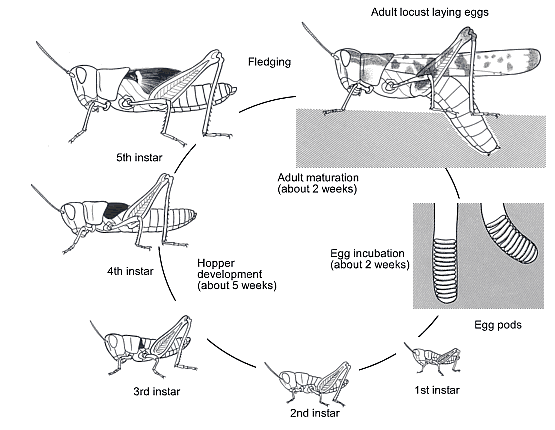Science - Rising of locusts
Cicadas, locusts, and grasshoppers are winged insects that primarily feed on plants and possess the ability to produce sound. Cicadas feature prominent, transparent wings and a rounded body shape. On the other hand, locusts are slightly smaller, characterized by a slender, straight body and robust hind legs designed for jumping. Cicadas are renowned for their distinctive, loud noises. Periodical cicadas spend either 13 or 17 years in the nymph stage, undergoing slow development underground. Remarkably, they emerge simultaneously every 13 or 17 years due to synchronization. With a lifespan of 17 years, they hold the title of the longest-living insect.
The earliest scientific research on locusts dates back to the early 1900s when Sir Boris Yvarov made significant discoveries regarding different phases in their life cycle. Unlike butterflies or moths, locusts undergo incomplete or direct metamorphosis, meaning there is no pupal stage. Additionally, the appearance of juveniles closely resembles that of adults.
The life cycle of Australian plague locusts can be divided into three main stages: egg, nymph, and adult. The accompanying diagram depicts the five instar stages that the locusts go through. It's important to note that the timeframes provided for each stage are approximate and are influenced by optimal conditions during the summer season.
The life cycle begins with adults laying eggs in the soil, which typically remain underground for approximately two weeks before hatching into nymphs.
Swarming behavior is a direct response to overcrowding. The transition of locusts into their swarming form is triggered by numerous interactions every minute for a duration of four hours. A massive swarm can comprise billions of locusts, spanning thousands of square kilometers, and with a population density of up to 80 million per square kilometer (200 million per square mile). When desert locusts come into contact, their nervous systems release serotonin, resulting in a mutual attraction that is essential for swarming.
Scientific research shows that locusts are very sensitive to sounds - both the sounds that they , themselves, make and the external sounds.

Courtesy of Dept. of Agriculture - Australia
Qur'an - Rising of locusts
Verse 54:7 informs us a couple of fascinating things. The verses in this section are about the disbelievers. A very brief summary of tafsir is provide here. The people who didn't believe in Allah, would emerge from the dead in the next world. Their humbled eyes show that they are fearful and, now, they are surrendering. Their movements are like waves after waves in an unorganized fashion. They are hurrying with fear. They resemble locusts rising out of the ground and unconsciously getting into swarms. What a beautiful analogy!
Why does the Holy Qur'an mention the locusts in this verse instead of other animals such as bees, birds, etc.? There must be something special about the locusts!
- The locus eggs are buried under ground similar to the people being buried after death.
- Locusts emerge from the earth and undergo a remarkable metamorphosis, akin to humans assuming a fresh existence in the afterlife, where our souls are liberated from their physical vessels.
- The disbelievers find themselves in a fearful and confusing situation, with no say in the direction they are being led. Just like how locusts swarm without intention. When desert locusts come into contact, their nervous systems release serotonin, creating a mutual attraction necessary for swarming. The disbelievers are brought together, clustered, akin to swarms of locusts, completely devoid of control.
- Interestingly, Verses 54:8 mentions the "Summoning Voice" and how the disbelievers run towards it in confusion. Scientific research shows that locusts are very sensitive to sounds - both the sounds that they, themselves, produce and the external sounds.
Key fact - In the early 1900s, significant findings were made regarding the various stages of the locust life cycle. Surprisingly, this knowledge was unknown to people 1400 years ago. It was not understood that locusts lay their eggs underground, lying dormant for extended periods before emerging from the soil, almost like a resurrection from the dead. The Qur'an beautifully illustrates this resemblance, drawing a parallel between the locusts' reawakening and the resurrection of humanity.
خُشَّعًا أَبْصَـٰرُهُمْ يَخْرُجُونَ مِنَ ٱلْأَجْدَاثِ كَأَنَّهُمْ جَرَادٌ مُّنتَشِرٌ
Their eyes humbled, they will emerge from the graves as if they were locusts swarming 54:7
مُّهْطِعِينَ إِلَى ٱلدَّاعِ يَقُولُ ٱلْكَـٰفِرُونَ هَـٰذَا يَوْمٌ عَسِرٌ
running in confusion towards the Summoning Voice; [and] those who [now] deny the truth will exclaim, “Calamitous is this Day!” 54:8
